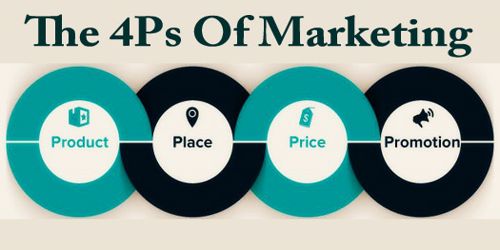The 4Ps of marketing are the four essential factors involved in marketing a good or service to the public. These include the marketing mix, which is a range of methods a business uses to influence customers in buying their product. Also referred to as the marketing mix, the 4Ps in the overall business climate are influenced by internal and external influences and communicate extensively with each other.
The 4Ps make up a typical marketing mix – Price, Product, Promotion, and Place. The 4 Ps are utilized by companies to spot some key factors for their business, including what consumers want from them, how their product or service meets or fails to satisfy those needs, how their product or service is perceived within the world, how their rivals stand out, and the way they communicate with their customers.
The concept of the 4Ps has been around since the 1950s; because the marketing industry has evolved, the concepts of individuals, processes, and physical evidence became important components of selling a product, too. The marketing formula (mix), however, nowadays increasingly involves many other Ps such as Packaging, Positioning, People, and even Politics as critical mix components.
Understanding the 4 Ps of marketing –
In the business sector, the marketing managers plan a marketing strategy taking into consideration all the 4Ps.
Product: A product is any good or service that fulfills consumer needs or desires. The merchandise is often intangible or tangible because it is within the type of services or goods. To achieve success, marketers must understand the life cycle of a product, and business executives must have a concept for coping with products at every stage of their life cycle. The merchandise must deliver a minimum level of performance; otherwise, even the simplest work on the opposite elements of the marketing mix won’t do any good.
Organizations or companies may either change the packaging, after-sales operation, warranties, and price range or extend to new markets to achieve their goals. There is an old saying stating for marketers, “What can I do to offer a better product to this group of people than my competitors”; this strategy also helps the company to build brand value.
Price: Price is the cost customers pay for a commodity and it’s a very important part of the concept of the marketing mix. Production, cost, competitive demand patterns, and government regulations are key factors that decide pricing. Price is the most important aspect of a marketing campaign, as it determines the existence and benefit of a product. Pricing can also be used a demarcation, to differentiate and enhance the image of a product.
Price usually reflects the product’s perceived value instead of its real value. In some cases, business executives may raise the value to convey the merchandise the looks of being a luxury. Alternatively, they will lower the value so more consumers can try the merchandise. Things to stay on mind while determining the value of the merchandise are, the competitor’s price, list price, customer location, discount, terms of sale, etc. it’s also important to investigate when and if techniques like discounting are required or appropriate.
Place: For any sector, the main goal of a successful distribution or ‘place’ (location) strategy is to catch the consumer’s eye and make it convenient for her to buy it. When a company makes decisions regarding place, they’re trying to see where they ought to sell a product and the way to deliver the merchandise to the market. The first motive of managing trade channels is to confirm that the merchandise is quickly available to the customer at the correct time and place. The goal of business executives is usually to urge their products ahead of the consumers that are the foremost likely to shop for them.
Distribution channels like outsourcing or company transport fleets are decided upon after analytic thinking. In some cases, this might talk over with placing a product in certain stores, but it also refers to the product’s placement on a particular store’s display. Retailers pay a premium for the correct location. For certain cases, placement may refer to the act of putting a product on TV shows, for movies, or on web pages to draw publicity for the product.
Promotion: Promotion is a marketing communication process that helps the company to publicize the product and its features to the public. Promoting a product is aimed at explaining to customers that they need it and why they should pay a certain amount. This covers ads, salesforce decisions; direct marketing, public relations, advertisement budgets, etc. This can also include consumer schemes, direct marketing, contests, and prizes. It is the most expensive and essential component of the marketing mix, that helps to grab the attention of the customers and influence them to buy the product.
The primary aim of promotion is to spread awareness about the merchandise and services offered by an organization. Most of the marketers use promotion tactics to push their product and reach bent on the general public or the target market. It helps in persuading consumers to decide on a selected product over others within the market.
All the marketing mix elements have an effect on one another. They make up a business strategy for a corporation and if done correctly, can be a huge success to it. Yet done wrong and it could take years for the company to recover. The marketing mix requires a lot of awareness, market analysis, and multi-person consultation, from consumers to trading to manufacturing and many others.
Information Sources:
















